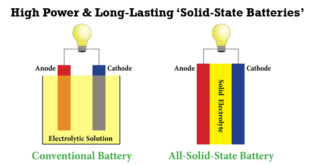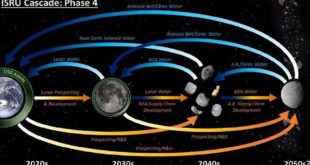Naval Warfare depends a large extent on lethality and survivability of submarines, its principal weapon, therefore Navies have been researching new ways to make them quieter and increasing their underwater endurance. Propulsion system plays an extremely important role in the functioning of a submarine for the completion of its desired operations.
Traditional diesel-electric submarines need to surface frequently to charge their batteries and have an underwater endurance of only a few days. As battery technology improved, the endurance of these submarines increased proportionally. But it was not enough to last them beyond a week. Therefore these submarines need to surface to to recharge them.
Navies were demanding Air-independent propulsion (AIP) technology. AIP is any marine propulsion technology that allows a non-nuclear submarine to operate without access to atmospheric oxygen (by surfacing or using a snorkel) thereby vastly improving their underwater endurance. AIP can augment or replace the diesel-electric propulsion system of non-nuclear vessels. AIP systems permit diesel-electric submarines to recharge their batteries independent of their engines. Also, it helps to reduce the noise without compromising the submarine performance. AIP systems have been in high demand due to their increasing advantages in performing stealth underwater operations.
In a ceremony in November 2019, Japan launched its latest submarine, the Toryu. It is its second to be equipped with lithium-ion batteries. Japan is the first country to field this game-changing technology in diesel-electric submarines. Japanese submarines also have an Air-Independent Power (AIP) system. This uses closed-cycle ‘Stirling’ diesel engines to generate electricity to turn the propeller while the submarine is submerged. This means that submarines can patrol longer without surfacing, thus preserving their stealth.
The Soryu class is already a very modern submarine, having been introduced into service just over a decade ago. As an outgrowth of the previous Oyashio class, these are not tiny boats, displacing 4,200 tons submerged and measuring 275 feet long, They are the largest submarines Japan has constructed since the end of World War II. They also feature an “X” tailplane configuration for extreme maneuverability in tight littoral environments.
Japan’s next generation ‘29SS’ submarine may abandon AIP altogether and rely on a large bank of lithium-ion batteries, and just like submarines dating back before World War I, they will run undersea on battery power alone.
The advantage of pure lithium-ion batteries over AIP is power: so far AIP has never provided enough power to propel a submarine at full speed underwater. For this submarines anyway resort to their batteries. And the AIP is not powerful enough to recharge the batteries so the old-fashioned diesel generator is still required for that. Additionally AIP systems require dangerous substances to run, typically liquid oxygen and hydrogen.
AIP enhances the stealth of a submarine, its key characteristic, but at the cost of size, complexity and maintenance. An AIP submarine still needs a diesel generator and still needs a large bank of batteries. Most navies see the trade-offs as worth it, but lithium-ion batteries promise to change this equation. Having better batteries removes the need for the AIP, thus making the submarine smaller and easier to maintain.
The attractiveness of battery powered submarines is increasing due to continuous improvement of batteries. Light-metal battery propulsion power will greatly enhance the mission effectiveness of such a submarine at long range. Between 2025 and 2030, the continuing rapid evolution of lithium-ion battery technology will enable the Attack-class boats to stay fully submerged on low-speed patrols for up to 40 days without recharging. By 2035, that could increase to up to 60 days. And by 2050, it’s conceivable that the next generation of light-metal batteries will enable the boats to go on an 80-day long-transit mission without the need to resurface and recharge, write Derek Woolner and David Glynne Jones.
South Korea is also planning to adopt lithium-ion batteries for their future submarines. Their latest Jangbogo-III class boats are already among the most well armed non-nuclear submarines in the world.
Australia’s attack submarines will be diesel electric featuring lead-acid batteries
Ten years after the intention to replace and double the size of Australia’s submarine fleet was disclosed in the 2009 Defence White Paper, construction of the first of 12 conventionally-powered Attack-class boats under Project Sea 1000 is set to begin in 2023. All being well, the first-of-type will eventually be launched in 2030 and undergo harbour acceptance trials. These will be followed by 18 months of contractor sea trials, including a docking period if required, that will culminate in delivery to the RAN in 2032.
In announcing the selection of DCNS as the program’s international partner in April 2016, Turnbull referred to the superior sensor performance and stealth characteristics offered by the Shortfin Barracuda 1A. Other considerations had included requisite range and endurance as well as cost, schedule, program execution, through-life support, and Australian industry involvement.
The pre-concept design for the Shortfin Barracuda 1A envisaged a boat 97 metres long equipped with four diesel alternators to generate electricity, a large permanent magnet motor, hydroplanes that could retract to reduce noise and drag, and a pump jet propulsor instead of a propeller to reduce radiated noise and avoid cavitation, particularly at higher speeds.
The diesel-electric propulsion system would feature lead-acid batteries rather than the lithium-ion type that had been proposed by the German and Japanese contenders, although a later move to lithium-ion was acknowledged as an option. Gerard Autret, chief naval architect of the Shortfin Barracuda, emphasised that the Future Submarine would not be a conversion of the nuclear-powered Barracuda, but a new design using the Barracuda as its design reference.
Germany’s MTU was named in early 2019 as supplier of the diesel generators that turn mechanised energy into electricity. Suppliers of the main electric motor, main DC switchboards, main storage batteries and weapons discharge systems, all of which will contribute to the design solution, are being finialized..
South Korea’s New battery can double the operational time of submarines
South Korea says it has developed lithium-ion batteries that can double the operational hours of submarines compared to those with lead-acid batteries.
The lithium-ion batteries were created for the country’s next-generation attack submarines, expected to launch in the mid-2020s, according to the Defense Acquisition Program Administration, or DAPA. Following 30 months of development, the batteries passed a technology readiness assessment, a step toward integration on a weapons platform, the agency said in a news release.
“Development of lithium-ion batteries for submarines is a great achievement in the global submarine market,” said Rear Adm. Jung Il-shik of the DAPA’s next-generation submarine project group. “We expect this successful development of lithium-ion batteries to raise South Korea’s reputation as a submarine maker, as well as to have a great ripple effect through the commercial sectors.”
Samsung SDI, the world’s largest supplier of lithium-ion batteries, including ones for cellphones, manufactured the battery module to be mounted on the second batch of three KSS-III submarines. Hanwha Land Systems is responsible for integrating the modules and other parts on the submarine, which is built by Daewoo Shipbuilding & Marine Engineering.
The first of the three locally designed KSS-III Batch I diesel-electric submarines was launched in September, and two more hulls are expected to be under construction until 2024. According to the DAPA, the KSS-III class is 83.5 meters long and has a beam of 9.6 meters. It has a displacement of 3,358 tons when surfaced, and 3,705 tons when submerged.
The boat is known to be equipped with six vertical launch system tubes and able to accommodate a locally developed cruise missile. It can sail at a maximum speed of 20 knots with a cruising range of 10,000 nautical meters, DAPA officials said.
References and Resources also include:
https://www.aspistrategist.org.au/future-proofing-the-attack-class-part-1-propulsion-and-endurance/
https://www.australiandefence.com.au/defence/sea/attack-class-plan-of-action
 International Defense Security & Technology Your trusted Source for News, Research and Analysis
International Defense Security & Technology Your trusted Source for News, Research and Analysis


